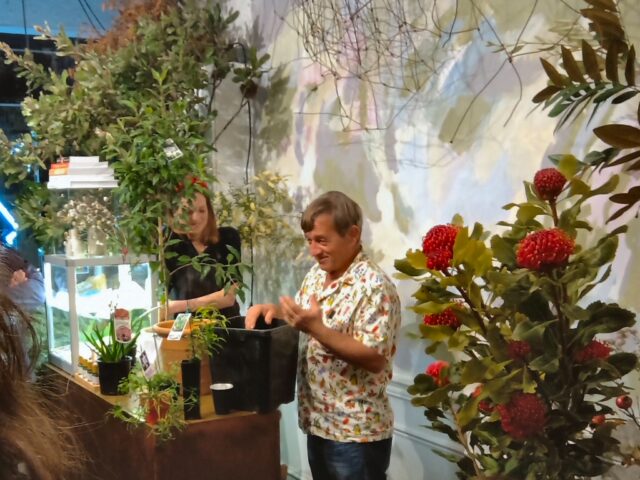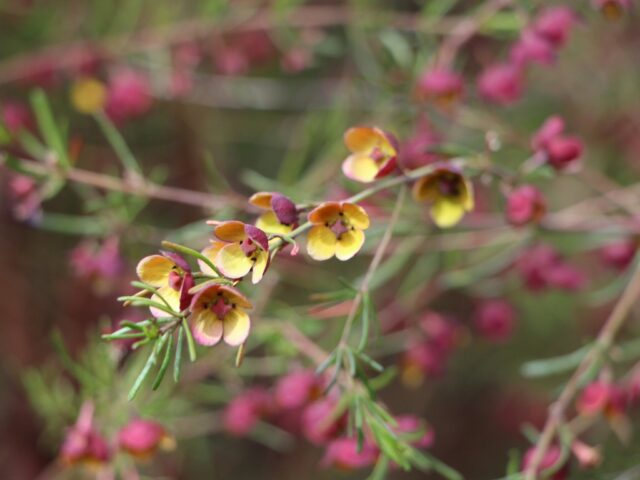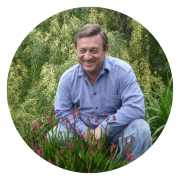I had a fantastic time speaking at Bess Flowers in Paddington a few weeks ago, surrounded by stunning native flowers and great company! I spoke about growing natives in urban settings, as Bess had a lot of customers who had asked about growing Australian plants in their gardens. To finish up, we did a demonstration of potting up a few bush food plants with different growing habits into one container to create a beautiful layered native herb pot, perfect for compact spaces. We talked about which natives will attract birds to smaller gardens so that even the most space challenged gardener can create their own little wildlife habitat. The key here is to look for natives with tubular flowers, such as kangaroo paws or Correa species, which have evolved to be pollinated specifically by birds. Australia has a great variety of other flowers pollinated by birds too, such as eucalypts, banksias, bottle brushes and many more, so there are plenty of beautiful native plants you can use to attract birds.
We talked about which natives will attract birds to smaller gardens so that even the most space challenged gardener can create their own little wildlife habitat. The key here is to look for natives with tubular flowers, such as kangaroo paws or Correa species, which have evolved to be pollinated specifically by birds. Australia has a great variety of other flowers pollinated by birds too, such as eucalypts, banksias, bottle brushes and many more, so there are plenty of beautiful native plants you can use to attract birds.
We also talked about the soil in urban areas, which may not always be simply just garden soil. Soils in Sydney and other urban places can be contaminated with building waste products which affect the quality and pH, so it’s a good idea to test the soil before planting into the ground. You might need to add significant amounts of organic matter to the soil or other substances to balance the pH, but much easier is to just grow things in containers. Growing plants in containers allows you to create the perfect growing conditions for whatever you want to grow, because you have much more control over soil type, drainage and location of the plant. That means you can grow natives that require very particular soil types or growing conditions, such as the phosphorus-sensitive Grevillea species or the sometimes temperamental but exquisitely perfumed brown boronia (Boronia megastigma). The bush food potting demonstration showed how you can create structural and flowing shapes with minimal space, and grow edible native herbs at the same time! We took quite a large pot and placed an aniseed myrtle (Backhousia anisata) in the centre to create some height, and then placed a river mint (Mentha australis) and sea celery (Apium prostratum) at the base of the shrub, and these two plants cascade down the side of the pot due to their prostrate growth habit. The result is a beautifully scented bush food bowl which you can place on a balcony or in a courtyard and pick for teas and cooking. Unfortunately I forgot to take a picture of the finished result, so you will just have to imagine how it looked! It was a lovely evening all round and a pleasure to share knowledge about native plants and gardening.
The bush food potting demonstration showed how you can create structural and flowing shapes with minimal space, and grow edible native herbs at the same time! We took quite a large pot and placed an aniseed myrtle (Backhousia anisata) in the centre to create some height, and then placed a river mint (Mentha australis) and sea celery (Apium prostratum) at the base of the shrub, and these two plants cascade down the side of the pot due to their prostrate growth habit. The result is a beautifully scented bush food bowl which you can place on a balcony or in a courtyard and pick for teas and cooking. Unfortunately I forgot to take a picture of the finished result, so you will just have to imagine how it looked! It was a lovely evening all round and a pleasure to share knowledge about native plants and gardening.
In solidarity with the climate strike on Friday, 20 September, I was deep planting Tasmanian blue gum trees on the farm. These beautiful trees will have a much higher survival rate because they have been deep planted, and they are a wonderful natural climate solution because they will store more and more carbon as they grow, whilst also providing a host of other benefits. Another important part of helping trees get established is keeping weeds down around the new planting, and a great ecological way to do this is to use cardboard boxes from around the house as a weed mat. Tino showed me a great little trick to keep the cardboard in place too. I had been using metal pins to hold the cardboard down, but Tino showed me how he just breaks up some sticks and use them as stakes through the cardboard, and then you have free, biodegradable stakes! I then drill a hole through the middle of the cardboard to plant the tree into.
Coming into spring, I’ve been planning what I’m going to grow this season, and I’ve got plans for a big tomato crop. I’ll be growing a range of heirloom tomato varieties over the summer to make into passata and other delicious things. I’ve recently built a covered vegetable garden which I will be planting out very soon, so I’ll keep updating on that over spring and summer. There are a few different challenges here on the farm, and I’ve been finding natural, non-toxic methods of rehabilitating the land. I’ve got quite a bad thistle problem, and I recently started using a great tool to remove them manually. The tool has two prongs which allow you to pick up the thistle and remove it easily without having to get close or touch it. Removing them this way is the best method because I can manage the problem without using herbicides, which is part of the long-term management of the farm and taking care of the land here.
At Mac Point in Hobart, we’ve got some fantastic workshops about growing summer vegetables coming up in the next few months which are free to attend! If you are in Tassie and want to attend, you just have to register online by emailing contact@macquariepoint.com. Places are limited. The workshops cover the whole process of growing summer vegetables, from planting to harvesting.
The workshop dates are:
Saturday, 5 October – preparing, propagating, planting
Saturday, 2 November – training and maintaining
Saturday, 7 December – harvesting and composting
